Silver Tip Beef Cut Pot Roast
This post has been a long time in coming. And not just because it's taken me a while to write it. But because it's taken me a while to learn it. Like many home cooks, when it came to meat preparation, I was stumped. I didn't understand the different cuts of meat or how to prepare them. After lots of reading, and a hands-on butchery class at The Center for Kosher Culinary Arts, I feel like I finally have a good grasp of kosher meat preparation and handling.
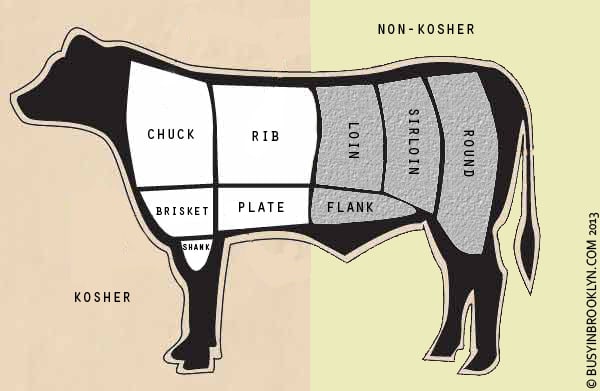
First things first: Where does the meat that we eat actually come from? The different cuts of meat that you buy at the butcher come from a steer. The steer is cut up into 9 sections, or PRIMAL CUTS, five of which are kosher. The chuck, rib, brisket, shank and plate are cut into subprimals or fabricated cuts, which is what you see at the supermarket.
The most important thing to understand about the beef that we eat is where it comes from. Meat is made up of muscle and connective tissue. The more the muscle is used, the more connective tissue it will have causing the meat to be tough. For example, the chuck, which is the shoulder of the steer, is one of the most used parts of the animal resulting in a tough cut of meat.
Why does it matter where our meat comes from? Well once we understand the nature of the meat (if it's tough or tender) we will know what type of cooking method it requires. Tough cuts of meat needs moist cooking to break down the muscle fibers and connective tissues. Tender cuts require dry heat cooking methods to firm up the meat without drying it out.
Now, let's get into fabricated cuts and how they are broken down.
Unfortunately, for the kosher consumer, it's hard to know what you're really getting in the butcher shop. Kosher butchers (and butchers in general) tend to name their cuts however they like. That being said, these are the most general fabricated cuts that you'll find:
CHUCK:
Chuck roast is often sold tied in a net and includes the Square Roast (top portion) and the French (or Brick) Roast (bottom portion). Since the chuck portion is very tough, it is often cubed and sold as stew meat as well. Kolichol is another tough cut from the shoulder section, and is great to use in the cholent or wherever a recipe calls for pot roast. Unlike chuck roasts that require moist heat cooking to tenderize the meat, Shoulder London Broil & Silver Tip Roasts (used to make Roast Beef) that are also cut from the shoulder, can be roasted using a dry heat cooking method until medium-rare.
One of the most popular and tender cuts from the shoulder is the minute steak roast. You would probably recognize it from the thick piece of gristle that runs down the center. When the roast is sliced horizontally above and below the gristle, the resulting cuts are often called filet split and are perfect for quick cooking in stir fry's or wherever recipes call for quick grilling (such as london broil or flat iron steak).
A note about London Broil: London Broil is not actually a cut of meat, but rather a method of preparing the meat by broiling or grilling marinated steak and then cutting it across the grain into thin strips. Butchers use different cuts of meat for this, some more and some less tender. If you are curious as to where the London Broil is cut from, simply ask your butcher.
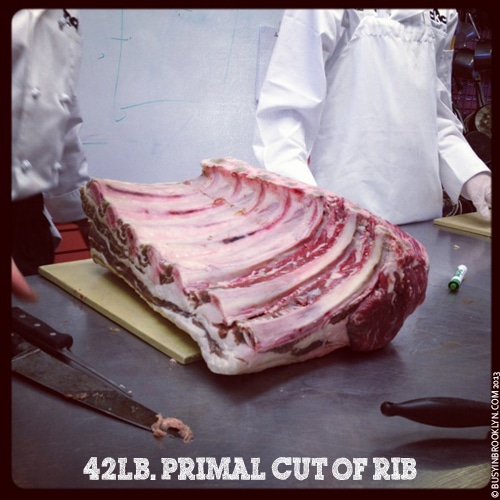
RIB:
Ribs are the most tender cut of kosher meat because the muscles in this area are not worked as much. Ribs should always be cooked using a dry heat cooking method. The rib section includes, rib steaks, ribeye steaks, club steaks, delmonico or mock filet mignon (which uses the center EYE of the rib). There is also a great cut known as the Surprise steak – a flap that covers the prime rib and is tender and delicious. Above the surprise steak is the "Top of the Rib" which some butchers call the "Deckle". This is the one exception to the rule of the rib section. Top of the Rib is a tougher cuts and benefits from moist heat cooking.
Besides the rib primal, ribs can also be found in the chuck primal, which includes the first five ribs of the ribcage. That is where flanken and short ribs comes from. Short ribs are strips of meat & fat that are cut from between the ribs, while flanken is a cross-section cut, including pieces of the rib in between the meat & fat. Spare ribs are short ribs that have been cut in half lengthwise. Both short ribs and flanken benefit from moist heat cooking.
PLATE:
The plate sits below the rib primal and includes the flavorful skirt and hanger steaks. Both have a high salt content and benefit from quick grilling.
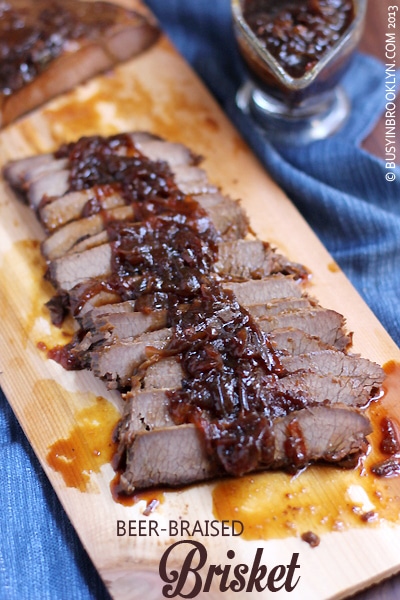
BRISKET:
Brisket is the breast of the steer and is an extremely tough cut. A whole brisket can weigh as much as 15 lbs. Brisket is often sold as 1st and 2nd cut. First cut brisket is flat and lean. It is much less flavorful than the second cut, which is smaller but fattier. In general, fattier meat will always yield a tastier product. Fat is flavor, so when possible, always opt for a well-marbled cut over a leaner one. You can always refrigerate the meat and remove the congealed fat later on.
First cut of brisket tends to cut nicely, while second cut tends to shred, making it perfect for pulled beef. Corned beef & pastrami are popularly made from brisket. Corned beef is pickled while pastrami is smoked.
FORESHANK
The foreshank is very flavorful and high in collagen. It includes the shin and marrow bones. Because collagen converts to gelatin when cooked using moist heat, foreshanks are excellent for making stocks.
ADDITIONAL PARTS
In addition to the primal cuts of the animal – there are other edible parts of the steer including the neck (mostly used ground up due to it's connective tissues), cheek (great for braising), sweetbreads (thymus gland), liver, tongue and oxtails (hard to find kosher due to the complications involved in removing the sciatic nerve).
GROUND BEEF
Ground beef can come from any part of the animal, but it is usually made from lean cuts and trimmings. Grinding the meat helps to tenderize it, so the toughest cuts are often used. When purchasing ground beef, keep in mind that the leaner the meat, the drier your end product will be. 80% lean to 20% fat is a good ratio.
OTHER CUTS NOT MENTIONED
There are lots of different cuts available that are not mentioned here, and the reason for that is because every butcher has different scraps and pieces of leftover meat that they choose to label at their own convenience. Pepper steak at one butcher might come from the chuck and at another butcher, from the deckle. If you want to use your meat for a specific purpose, and you don't want to have to braise it for a long time in order to tenderize it, order a specific cut from your butcher, or ask where the prepackaged meat comes from.
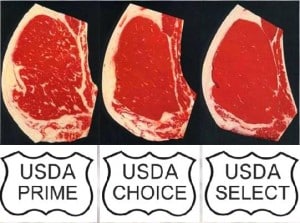
GRADING
All meat is graded by the USDA to ensure that it is fit for human consumption. Grading provides a system by which distributor (and consumers) can measure differences in quality of meats. Grades determine the tenderness and flavor of the meat base on its age, color, texture and degree of marbling. USDA Grades include: Prime, Choice, Select and Standard. You've probably heard of USDA Prime Grade meats. They are often used in fine restaurants. USDA Choice is the most commonly used grade in food service operations.
COOKING METHODS:
As I mentioned above, once you know whether your meat is tough or tender (due to muscle movement & connective tissue) you will understand how to cook it. Tough meat requires slow, moist heat cooking to help break down the connective tissue and tenderize the meat. Tender meat requires dry heat cooking to firm up the proteins without breaking down connective tissue.
DRY HEAT COOKING
Dry heat cooking can include broiling, grilling, roasted or sauteing/pan-frying. Meat should be cooked at high temperatures to caramelize their surface. To determine doneness, check the temperature with a meat thermometer. Over time, you will learn to "feel" for doneness based on the meats resistance when poked with a finger.
Thermometer readings:
very rare (sometimes referred to as "blue" meat) 120-125
rare (deep red center) 125-130
medium rare (bright red center) 130-140
medium (pink center) 140-150
medium well (very little pink) 155-165
well done (all brown) 165+
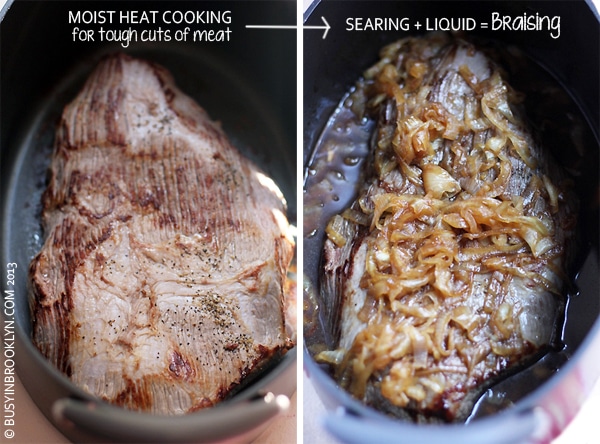
MOIST HEAT COOKING
Moist heat cooking includes simmering (used for corned beef and tongue) and combination cooking methods: braising and stewing.
Combination cooking methods use both dry and moist heat to achieve a tender result. Meats are first browned and then cooked in a small amount of liquid. Wine and/or tomatoes are oftened used as the acid helps to break down and tenderize the meat. The meat and liquid are brought to a boil over direct heat, the temperature is reduced and the pot is covered. Cooking can be finished in the oven or on the stove top. The oven provides gentle, even heat without the risk of scorching. To determine doneness when braising or stewing, the meat should be fork tender but not falling apart.
The main differences between braising and stewing are that stewing uses small pieces of meat, while braising uses a single, large portion. In addition, braising requires liquid to cover only 1/3-1/2 of the meat while stewing requires that the meat be completely submerged in the liquid.
RESTING & CUTTING MEAT
When meat has finished cooking, it's always important to let it rest (10-20 minutes) before slicing. Resting allows the juices to redistribute themselves, and cutting into the meat too early will cause all the juices to run out of the meat.
Another thing to keep in mind when cooking meat is CARRYOVER COOKING. When meat is finished cooking and removed from the heat, the internal temperature still continues to rise while the meat continues cooking. Therefore, keep in mind carryover cooking when using dry heat cooking methods. If you are looking for a medium doneness, and you pull your meat off at 150 degrees, the meat will continue to cook until it's temperature reaches about 155, resulting in medium well doneness.
As mentioned, meat is a group of muscle fibers that band together to form muscles. When cutting meat, it's important to cut against the grain (perpendicular to the muscle fibers) in order to shorten the muscle fibers so that they are more tender. Cutting parallel to the muscle fibers results in chewy, stringy cuts of meat.
MEAT RECIPES
beer braised brisket with onion gravy
pulled BBQ brisket
pepper steak with plum sauce
spaghetti squash bolognese
Rosh Hashanah roast
london broil with red wine reduction
Post a Comment

Source: https://www.busyinbrooklyn.com/kosher-meat-guide-cuts-cooking-methods/
0 Response to "Silver Tip Beef Cut Pot Roast"
Post a Comment